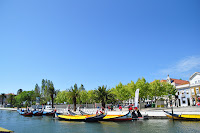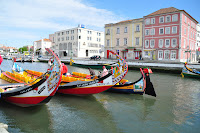We had an early start again, but first, we had to ride from Sintra to Gare do Oriente in Lisbon. We wanted to take the "Alfa Pendular" (like the ICE train in Germany, faster and more expensive) to Aveiro but then decided to take the cheaper "Intercidades" (the InterCity equivalent). It took a while until we could buy our tickets since there was really no visible information counter where we could ask. Besides, the English language was a challenge for the person at one counter where we've asked and didn't really made an effort. We didn't understand so we walked around to find a counter where we could buy our tickets.
They have a few for each destination and not centralised. Then, we have been whisked away to the right counter. The tickets cost 20€ per person for this 254 km route. We didn't know that the tickets were already with seats reserved and written on the tickets. We later learned that "CARR" is the wagon or car number and "LUG" is the seat number and we only realised the system after a few stops and when someone demanded his seat. We were apparently on the wrong wagon. Fortunately, the train was relatively empty, so we just stayed right there. It's a good thing though, but we didn't know it beforehand. In Germany, we have to pay extra if we reserve a seat, or else one is free to find the unreserved seats. Probably another downside of the reservation system is that there are no plans as to which part (A, B, C, D, E, F) which wagon or carriage going to stop so the passengers would know where to wait and don't run inside the whole train looking for their seats.
Arriving in Aveiro, we were kind of enthusiastic since the train ride was quite pleasant. We decided or better said my companion persuaded me to walk to the hotel instead of just jumping into a cab. It looked near on the map but dragging our heavy luggage on a 2 km partly cobblestoned road was no fun. It was quite depressing, and I was exhausted. At some point, we arrived at the bridge over the canal, and it was just a few meters from there to our hotel, the Hotel das Salinas along the canal. We booked the studio room for 75€ per night. The studio room was not something special, but it was big enough and comfortable. It has a practical desk for postcard writing perhaps, (it made a good impression) a nice bathroom, a plasma TV, a cooking area with refrigerator, stove, microwave oven, a coffee machine, coffee, tea, milk and assortments of cookies.
In particular, the location is excellent (unless you are walking with heavy luggage from the train station) and conveniently located in the centre of a tranquil, small town right next to the canal. A large shopping centre with bistros and restaurants is only five minutes away on foot. You can also walk from there to the salt pans. There was also the bus stops for the region and to the beaches a few meters away. The stop for inner-city buses is even a few minutes away on the other side of the bridge.
After a short break at the hotel, we then headed off to explore Aveiro. We have chosen Aveiro because it seemed like an excellent location to visit nearby destinations. Something unique about the place is its canals and the colourful moliceiro boats. It even got a nickname, the Venice of Portugal. On top of that are the beaches although they are not anywhere nearby but easily accessible by bus. One can also go to Porto in almost an hour from there for 6€ by rapid transit or a suburban transit (S-Bahn in Germany) which is part of the Porto-Aveiro transit system. Nearby and also accessible by train is also Coimbra. The bus line Citi Express even go to Viseu, Guarda, Castelo Branco, Lisbon and Covilha. From Viseu, one can still go further to Lamego where there's an impressive church which is also a pilgrimage site, the Nossa Senhora dos Remédios and goes back the same day with the rodonorte. From Porto, you can still continue to Braga and Guimarães which also part of the urban network transport system of Porto.
Arriving in Aveiro, we were kind of enthusiastic since the train ride was quite pleasant. We decided or better said my companion persuaded me to walk to the hotel instead of just jumping into a cab. It looked near on the map but dragging our heavy luggage on a 2 km partly cobblestoned road was no fun. It was quite depressing, and I was exhausted. At some point, we arrived at the bridge over the canal, and it was just a few meters from there to our hotel, the Hotel das Salinas along the canal. We booked the studio room for 75€ per night. The studio room was not something special, but it was big enough and comfortable. It has a practical desk for postcard writing perhaps, (it made a good impression) a nice bathroom, a plasma TV, a cooking area with refrigerator, stove, microwave oven, a coffee machine, coffee, tea, milk and assortments of cookies.
In particular, the location is excellent (unless you are walking with heavy luggage from the train station) and conveniently located in the centre of a tranquil, small town right next to the canal. A large shopping centre with bistros and restaurants is only five minutes away on foot. You can also walk from there to the salt pans. There was also the bus stops for the region and to the beaches a few meters away. The stop for inner-city buses is even a few minutes away on the other side of the bridge.
After a short break at the hotel, we then headed off to explore Aveiro. We have chosen Aveiro because it seemed like an excellent location to visit nearby destinations. Something unique about the place is its canals and the colourful moliceiro boats. It even got a nickname, the Venice of Portugal. On top of that are the beaches although they are not anywhere nearby but easily accessible by bus. One can also go to Porto in almost an hour from there for 6€ by rapid transit or a suburban transit (S-Bahn in Germany) which is part of the Porto-Aveiro transit system. Nearby and also accessible by train is also Coimbra. The bus line Citi Express even go to Viseu, Guarda, Castelo Branco, Lisbon and Covilha. From Viseu, one can still go further to Lamego where there's an impressive church which is also a pilgrimage site, the Nossa Senhora dos Remédios and goes back the same day with the rodonorte. From Porto, you can still continue to Braga and Guimarães which also part of the urban network transport system of Porto.
We started in Aveiro with a gondola trip through the canal system which was surprisingly good. There was not much going on in the city, and there were a group of five Slavic-speaking tourists who came, but we had enough space in the gondola. The tour started just around the corner from our hotel to the inner city, and then it went back towards the sea past the salt pans then back again and turned on into the other direction towards the area of the fish market. The girl tour guide told us many interesting things about the origins of Aveiro as a salt-making town, and we immediately got an overview of where these salt pans are, and they are just walking distance from our hotel. She also explained the gondolas and the canal system which were primarily used to transport salt and seaweed. The gondolas as I have previously noticed have interesting paintings on the hull which is a kind of satire I would say. On the front end is the religious motif and on the other end is something naughty. Anyhow, there was a small place to borrow bicycles for free, and I thought it was the best idea. Unfortunately, we were not able to use them because we wanted to visit other towns for the following days.
After the tour, we strolled around the old city area towards the Mercado do Peixe, the fish market and eventually to the church, the Igreja de Mesirecórdia. It was Monday, and most of the shops, restaurants and museums were closed. There was a bakery cum café near the church, so we got in and take our fill of coffee and delicious rolls. Remembering that the coffee in Portugal is an "espresso", I cautiously ordered a latte macchiato. Afterwards, we strolled through the pedestrian zone and found our first souvenir item, guess what, the salt from Aveiro. From there we walked toward the other public market, into a grocery store where we bought something for dinner, passed by the shopping mall on the other side of the bridge, to the different market and back bought our dinner then back to the hotel.
It was still early, so we decided to visit the salt pans nearby.
In the evening I ventured out to take some long-exposure photos.
After the tour, we strolled around the old city area towards the Mercado do Peixe, the fish market and eventually to the church, the Igreja de Mesirecórdia. It was Monday, and most of the shops, restaurants and museums were closed. There was a bakery cum café near the church, so we got in and take our fill of coffee and delicious rolls. Remembering that the coffee in Portugal is an "espresso", I cautiously ordered a latte macchiato. Afterwards, we strolled through the pedestrian zone and found our first souvenir item, guess what, the salt from Aveiro. From there we walked toward the other public market, into a grocery store where we bought something for dinner, passed by the shopping mall on the other side of the bridge, to the different market and back bought our dinner then back to the hotel.
It was still early, so we decided to visit the salt pans nearby.
In the evening I ventured out to take some long-exposure photos.
















































Wow!!! Speechless.......
ReplyDeleteSaudade! ;) Thanks for dropping by!
DeleteNice blog! I must say you have great writing skills. Aveiro holds a special place in my heart. I am excited to travel to Portugal next weekend. I cannot wait to explore the beauty of – The Portuguese Venice.
ReplyDelete